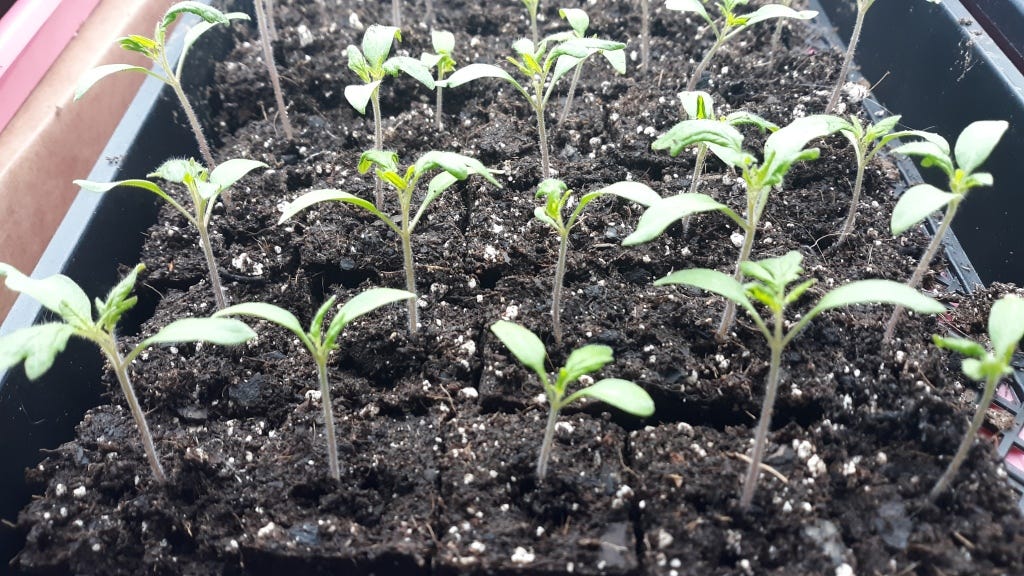Can we live without plastic? Yes, before the 1950's plastic wasn't everywhere in our world, in the kitchen, bathroom, even the garden. This spring I made a step in living in a "Post Plastic World" by moving away from the plastic seed starting cell packs I'd been using for years. I also am making a step away from "bagged soils" and learning how to garden in it's purest form....like God intended.
A Brief History of How Plastic Changed Our World | National Geographics
Plastics are known to have endocrine-disrupting chemicals that are toxic to our health and to our environment, even the government admits plastics are a bad idea. So why are we continuing to support this industry? The way to "vote" this out of our world and create a more healthy and sustainable future is to not buy the poison that is killing us. Vote with your dollar.
In the kitchen I purchase reusable silicone bags that zip closed and are freezer safe. I also purchased a 3 pack of plastic shower caps from the dollar store to use over bowls with leftovers in the frig instead of using a cling film plastic that comes on a roll. I can (hand) wash the shower caps and they don't actually touch the food, so I'm not as concerned about food grade. Yes, it's plastic...but it is reusable. The beeswax coated fabric covers don't always work for me but when they do, they are a better alternative.
Plastics in the Garden
I like to garden by following what nature has been doing for thousands of years. It is the way God intended for us to grow things. If we emulate what God has designed, we can save much of the "sweat of our brow" in keeping a garden. Work smart, not hard. Here is a perfect example of what I mean, Eliot Coleman's How To Make Compost and Add Organic Amendments and a lead into today's topic.
So follow me out to the greenhouse as I make an effort to change up my ways of gardening to move away from plastics and other petroleum based chemical products. I've been using bagged soils that I mix to start my seedlings off in late winter/early spring. I would fill a tray full of "cell packs" that I would plant my seeds into and later transplant into the garden or bigger pots. I discovered "soil blocks" and I was on board. I got a soil blocker (1.5" size) that makes 5 blocks at a time, the videos I watched online seemed to favor this size for the first time soil blocker and the smaller home gardener. I later purchased the smallest soil blocker for the tiny seeds which uses less soil but must be watered more often as the smaller blocks dry out quicker.
The idea is to start your seeds in the soil block but I was past that point with my tomato seedlings. The seed packet indicated 25 seeds but in reality it was closer to 100 seeds. I filled every cell (72 of them) in my tray and still had 3-5 seedlings in most cells. These babies need more room but I wasn't ready yet for a big pot and the small pots I had needed to be washed (another down side to plastic pots) or face the possibility of some virus or other vector from causing a seed germination failure. So....I started on my venture of soil blocking and I'm not looking back.
My initial goal was to get the consistency correct so I could form blocks using my tool and for the blocks to not fall apart on me. Later after I'd gotten that figured out I could modify the recipe with some amendments. I didn't want to waste time and money on the blocks until I had the right idea and was successful in having the stability first. I've noticed some of the most successful gardeners follow a recipe similar to this, Eliot Coleman's Recipe for making soil blocks.
The Results
A truckload of organic compost from a trusted source was delivered. I'll need to work on the recipe a little to use this in place of the bagged soil I experimented with. I'm making progress in the right direction and finding means to live without plastics in my life....one step at a time.
The plastic trays (1020) I use in the greenhouse were flimsy and usually cracked and broke in a year or two at most. I made an investment in trays that I purchased from Bootstrap Farmer that will never end up in the landfill because they will last the rest of my lifetime and beyond. I have warned my husband not to give away these trays like we did with the ones from the local nursery. I still keep a few of the cheap/free trays that come from the nursery when I buy plants, for any plants I gift. I usually buy a couple of flats of annuals from our local nursery to support them. I like snapdragons but they take FOREVER to grow from seeds and I don't have THAT much room.
If you think recycling is the answer to the problem of plastics, think again. I invite you watch this eye opening documentary, Dirty Business: What Really Happens to Your Recycling.
On another note, in the kitchen and elsewhere when possible I have found lots of uses for my canning jars instead of plastic containers. Leftovers, saving seeds, etc. so many ways if I just pay attention to all the ways plastics can be replaced and we can live in a "Post Plastic World".
Featured picture on today's post is a photo by Emily Bernal on Unsplash





